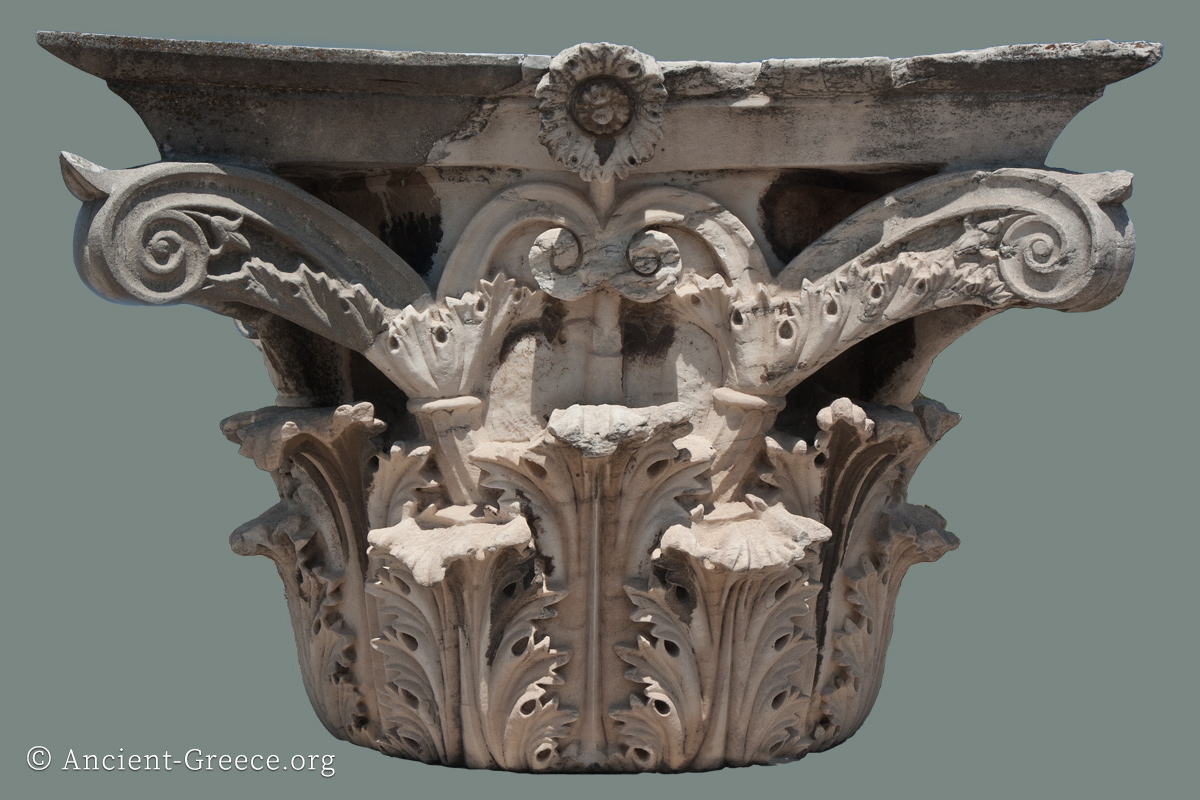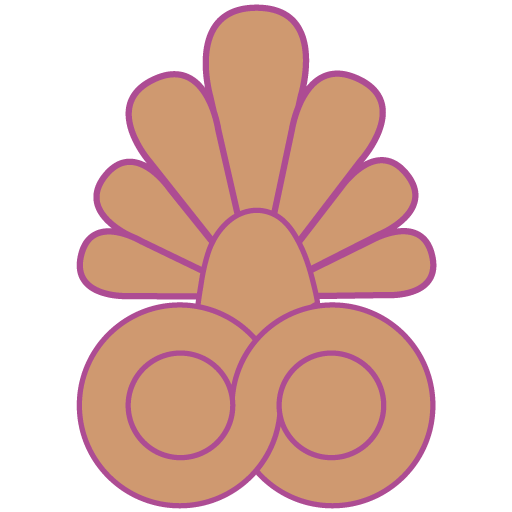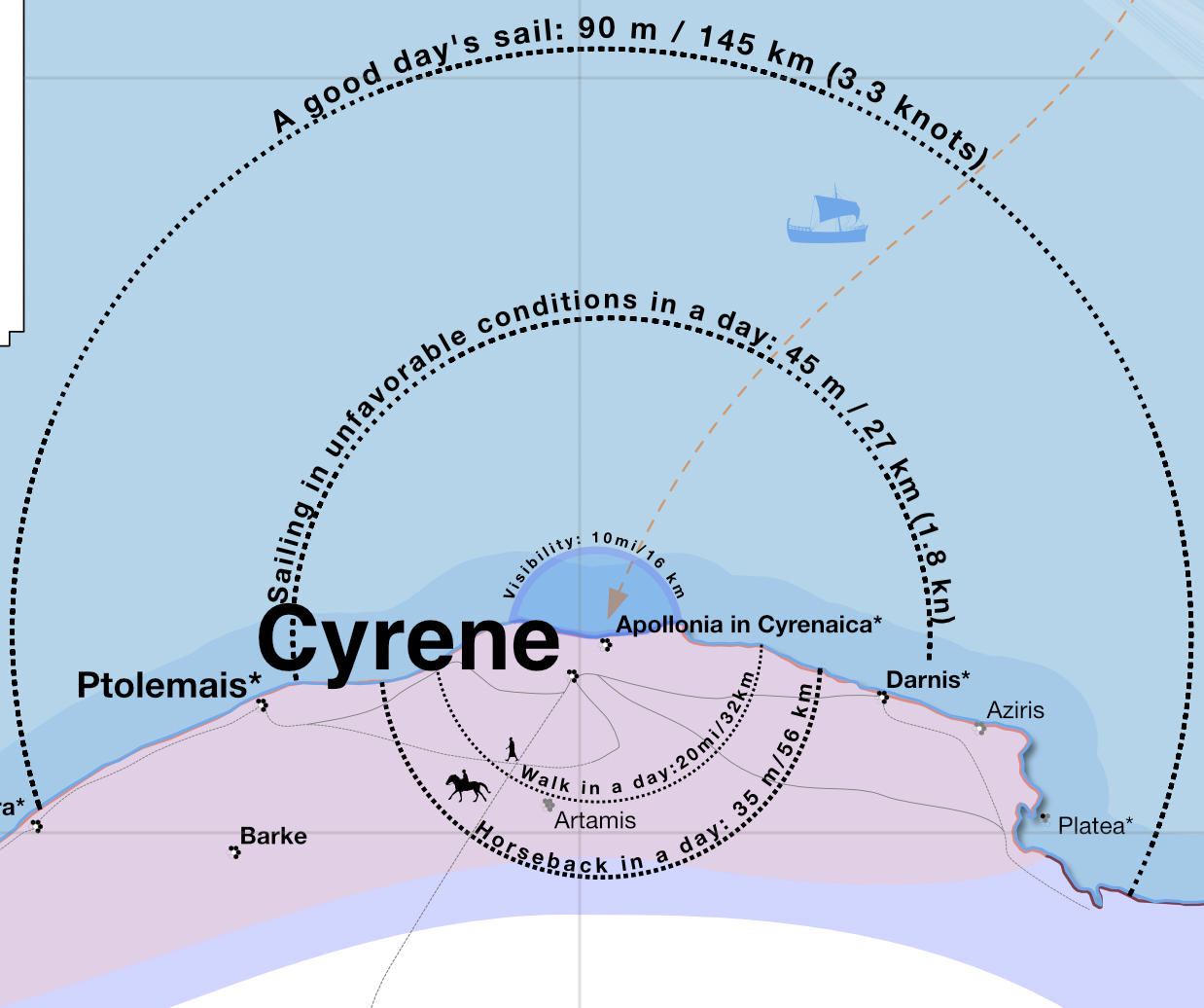
On this page:
Index and Sources
The complete Ancient Greece map contains over 1700 places, each hand-crafted and cross-checked.
A general list of sources can be found in the bibliography, while the map index (περιεχόμενα) contains place-specific sources. In general, trusted sources include a list of their primary sources.
Legend
Base Map
1:20,900,000
The base map was made with Natural Earth
https://www.naturalearthdata.com (NE2_LR_LC_SR_W_DR version 2.0.0, 1/30/2025)
Placemarks & Timemarks
The placemark is also a “timemark” that illustrates the story of ancient Greek settlements through time, at a glance.
It shows with a quick look, during which periods a place was relevant (inhabited, administered, etc.) for Hellenic civilization, and what its influence was in that era. In a cluster of cities, the more ancient ones will have hexagons active on the left, while in the later settlements, the right hexagons will be tinted.

Central hexagon: Location
White = certain (verified by archaeological and authoritative sources)
Gray = approximate
Ring of Hexagons (fill): Influence
Black:
Major influence for that era
Gray:
Lesser influence in that era
Empty:
Unoccupied, or unverified occupation in the era
Ring of Hexagons (position): Time
Bottom Left:
Stone Age (>3000 – 1100 BCE)
Left:
Bronze Age (3000- 1100 BCE)
Top Left:
Dark Age & Archaic Era 1100 – 480 BCE)
Top Right:
Classical Era (480 – 323 BCE)
Right:
Hellenistic Era (323 – 30 BCE)
Bottom Right:
Roman Era (30 BCE ~ 200 CE)
All placemarks are the same size. Relative importance in each era is indicated by the corresponding timemark fill, and the overall influence is indicated by the text size and weight (bold text).
Timemarks are relatively subjective. They indicate the general level of importance of the site, for each era, as construed from the various sources. The sources which are included in the index for each place provide the main guidance in determining each era’s importance.
Place Names
Ancient Greece spans three thousand years and, naturally, many settlements changed their name over time. Often, the ancients in their own time referred to places by different names or derivatives. To make things more confusing, in subsequent studies over the centuries, transliteration from Greeek to Latin characters never followed consistent rules. As a result, many settlements are known by several name variants.
To fit as many places as possible, only one of the known names for each place is given on the map where space is tight. In that case an asterisk indicates that alternative names for each place can be found in the map index, in their English and Ancient Greek versions.
The following naming conventions are used on the maps to reflect a places’ name variations over the centuries:
Name*: Additional name variations in the index
Name (Name): Other spellings or derivatives
Name, Name: Different names in same era
Name / Name: Name different through eras
Typography
Type size and weight denote the relative importance of each place, but in areas of tight space, a smaller font has been used.
Fonts: Helvetica Neue, Baskerville, and Pangolin.
The following typography guidelines give a good approximation of a place’s importance:
12 pt. Name: Place of Renown
10 pt. Name: Place of Influence
8 pt. Name: Place of Importance
7, 6, 5 pt. Name: Place of importance, or influence in tight space
smaller than 8 pt. Name: Place of note in tight space
In general, when space is tight, fonts get a click smaller; when space is ample, the largest possible fonts for each significance is used.
Color Key
F6E9B5
CF9970
EF7746
ECECE2
6F898B
1A4548
C5D1B5
92CB75
65BC45
BED7E8
70A7E8
0D79F2
DA9FFF
B0558F
7300A7
808080
F20D0D
000000
Period area highlights in general are assigned these colors:
Stone
Age
0C78F252
Bronze Age
93CC7642
Early Iron Age
F0764687
Classical Era
DA9EFF69
Hellenistic Era
F6E9B5
Visualizations
Scale Bar

The scale is very approximate and not to be trusted with precise measurements.
Stadia approximate scale is based on the reported ancient distance from Athens to Dekeleia of 120 stadia (Thucidydes).
Routes
Routes on sea and land are approximate. They indicate a general idea of the direction and reach of travel. Many on this map are based on later (Roman or Late Antiquity) roads.
Wind Patterns
The wind patterns of the Mediterranean profoundly shaped ancient history and culture, influencing everything from seasonal trade to military campaigns. In the era of sailing ships, prevailing winds were as critical to commerce and communication as mountains and valleys were to land travel.
Our map includes an approximate graphic representation of these wind patterns to illustrate their effect on the direction, speed, duration, and reach of ancient maritime travel.
Human Scale
Several map features have “human scale” indicators to help visualizing distances between places, including a “local city radius”, a “visibility horizon”, and several graphics representing approximate distance traversed in a day on foot, horseback, or by sailing in favorable or unfavorable conditions.
Visibility Horizon
A “shaded” blue area extending out from each island and shoreline indicates an approximate distance of how far a human can see.
Approximate visibility distance on the map is set at 16 km, or 10 mi. (at sea level: 3 miles; with slight elevation 12 miles). Hopefully it is useful to gauge distances and proportions, especially between the islands.
Circle of Influence
The radius represents approximate walking distance in a day, accepted here as 32 kilometers, or 20 miles, which can be traversed in about 6-8 hours at walking pace, and assessed to be the maximum distance where locals would interact with the land, each other, and their neighbors within overlapping areas during a day. Most activity around a city would probably be taking place around a radius of 6-8 miles, which is a distance a person could cover in a couple of hours on foot. A horse/mule or a cart, and other conditions would affect distance and time, but this map does not account for that.
In ancient Greece, a city’s center itself, as well as the surrounding countryside, farms, and villages that provided resources and supported the city’s population, or its polis, extended to a radius of approximately 15-20 kilometers (9-12 miles). The specific radius would vary depending on factors like terrain, population density, and the presence of other nearby settlements. An average person can walk about 25 miles in a day.
The radius does not factor a settlement’s renown or environs, so all radii are equal.
Printing the Maps
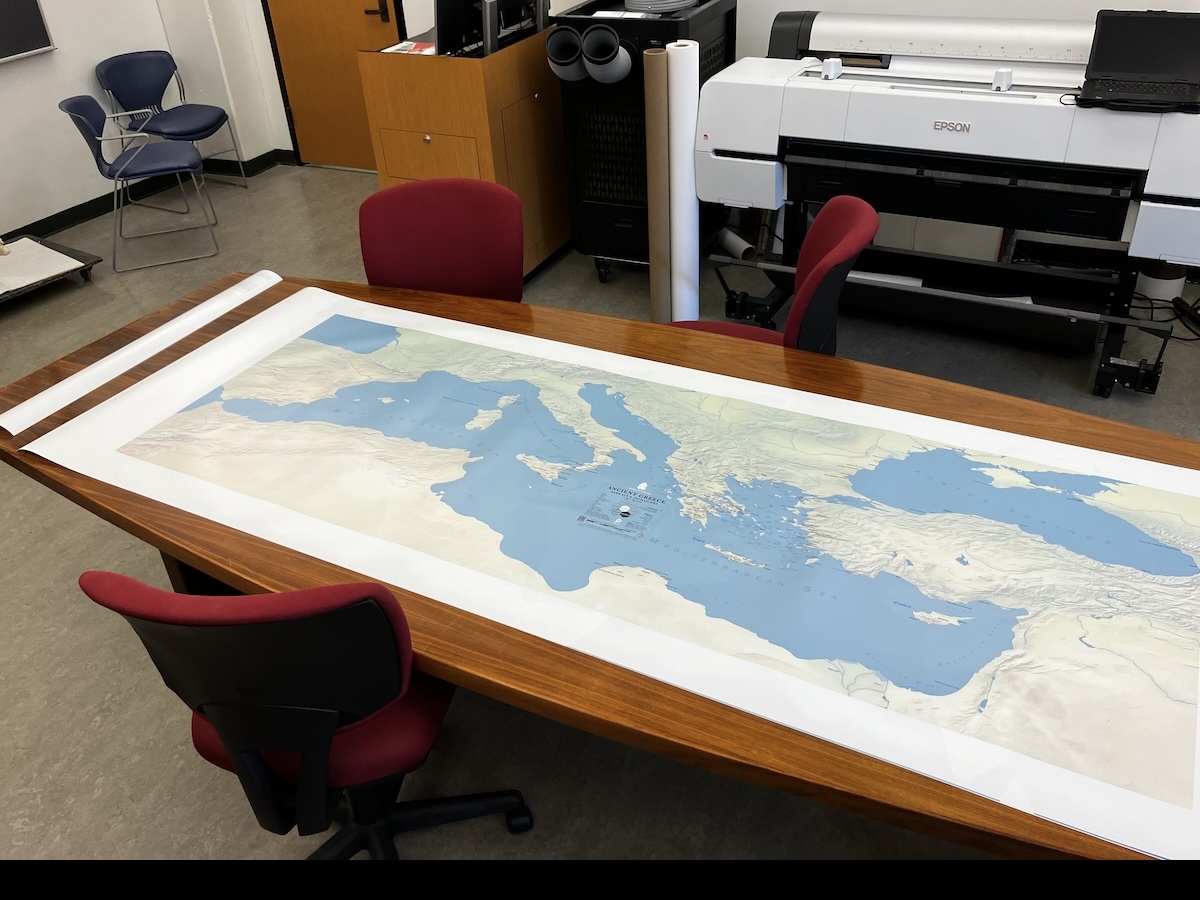
The maps are designed for digital viewing, but they do print well in poster-size dimensions and quality appropriate for wall-hanging.
Usage policy: These exclusive maps are free for personal use, but reproduction, remixing, embedding, translating, or publication in any form or media, sale, or relicensing is not allowed.
All rights reserved.
Appropriate use | Κατάλληλη χρήση
English:
Ancient-Greece.org provides the digital map only and does not sell/provide physical maps. Use your own, or a commercial printer to print the maps in the size you need.
The PDF documents come with permission to print, but otherwise they are protected from editing with a password which does not interfere with printing.
Appropriate use of map prints is restricted to personal and non-profit use, to hang in a private room, or in a physical classroom only. In any case, the map’s legend, copyright notices, and hyperlinks, must remain unaltered, clearly visible, and legible.
General printing guidance: The “Detailed” map (PDF) gives the best quality prints, but it must be printed in very large size, or the smaller labels will not be legible. The “abridged” maps (PNG) give legible prints up to 40 x 19 in (104 x 49 cm) wide prints. Anything larger than that will look pixelated.
Ελληνικά:
Ancient-Greece.org διαθέτει μόνο το ψηφιακό αρχείο. Χρησιμοποιήστε τον δικό σας, ή εναν επαγγελματικό εκτυπωτή. Τα PDF μπορούν να εκτυπωθούν σε υψηλή ποιότητα και μεγέθος αφίσας.
Τα έγγραφα PDF προστατεύονται από επεξεργασία με κωδικό πρόσβασης, ο οποίος δεν εμποδίζει την εκτύπωση.
Κατάλληλη χρήση εκτύπωσης των χαρτών μας είναι μόνο για προσωπική χρήση, για αίθουσα φυσικού σχολείου, ή ιδιωτικού δωματίου. Σε κάθε περίπτωση, το υπόμνημα, οι διαδυκτιακοί σύνδεσμοι, και οι αναγγελίες της πνευματικής ιδιοκτησίας πρέπει να παραμένουν αναλλοίωτα και ευανάγνωστα.
Γενικές οδηγίες για εκτύπωση: Ο λεπτομερής χάρτης (PDF) είναι καλύτερος για εκτύπωση, αλλά οι λεπτομέρειες διαβάζονται μόνο όταν εκτυπώνεται σε πολύ μεγάλες διαστάσεις. Οι συνοπτικοί χάρτες (PNG) διαβάζονται άνετα σε μέγεθος εκτύπωσης 40 x 19 in (104 x 49 cm), αλλά σε μεγαλύτερο μέγεθος θα φαίνονται πιξελιασμένοι.
Design tools used to make these maps

![]()
![]()
![]()
Natural Earth, QGIS, Affinity Designer, PDF. The PDF format was chosen as final output for its simplicity, usability, versatility, and printability. Ancient-Greece.org is not affiliated with any of these tools.
-
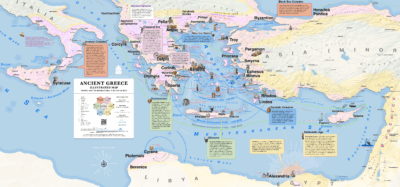
Ancient Greece Maps
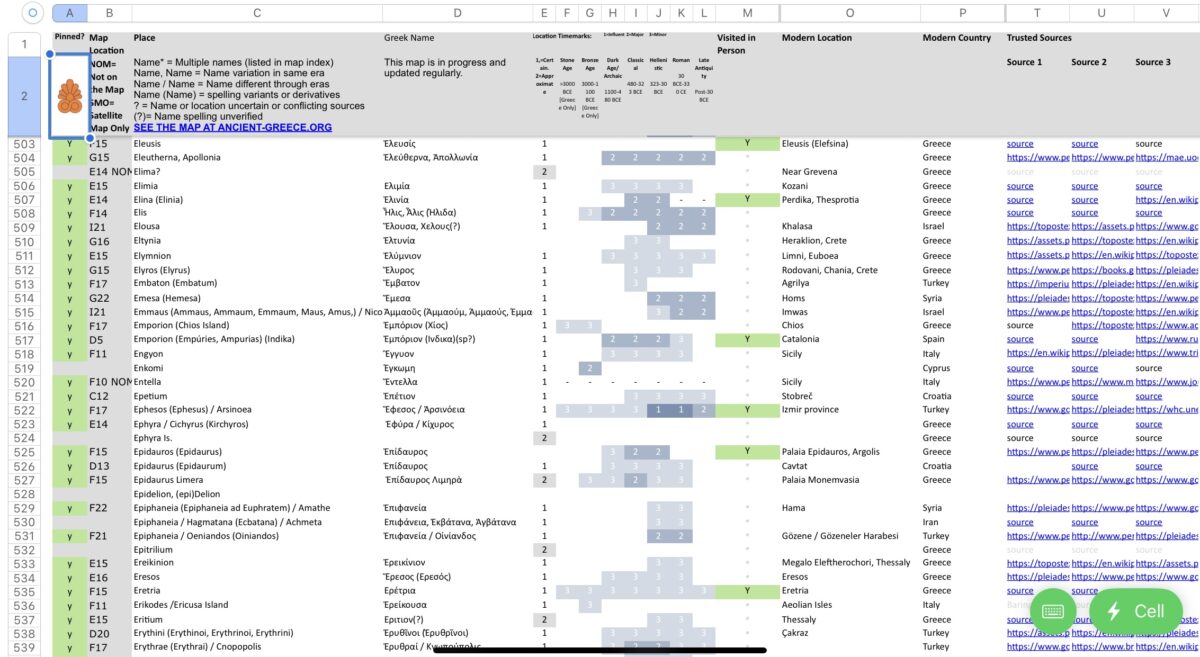
Ancient Greece Map index of places
Progress
The “Detailed • Complete” Ancient Greek map (referred to as “THE Map of Ancient Greece” includes every major and minor settlement researched in the last 25 years. It includes the entire area of Greek Civilization’s expance from Iberia, to the Black Sea, and from Egypt, to India. All of our maps are derived from this one.
The map is a living document in a constant state of development, with new additions, corrections, and amendments presented in each version.
Version numbers are located in the map legend.
Settlements: ~99% completed
Roads (inc. Roman/Late): 90%
Mountains: in progress
Rivers: in progress
Mines/Quarries: in progress
Sea routes: 90%
Civilizations: 99%
Battles: in progress
Sanctuaries: 99%
Spell-checking English: 1%
Spell-checking Greek: 40%
Theaters: 99%
Known Bugs
Zoomin stops:
Cannot zoom all the way in to read the smaller text when you click and open the image on a browser.
Solution: Download the file.
